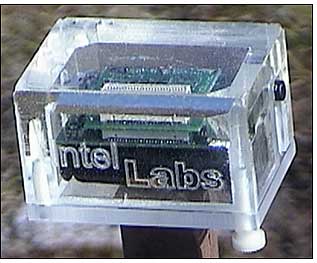Nov 23, 2004The widespread adoption of RFID to track goods through the global supply chain will mark the start of a new era in which the computers sense the world, anticipate the needs of people and act on their behalf, according to Hans Mulder, associate director of Intel Research, a unit of Santa Clara, Calif.-based Intel.
"We are on the verge of a vast increase in the spatial and temporal fidelity at which we [measure] and analyze the world," he said, speaking at Innovate 2004, an invitation-only RFID symposium for thought leaders hosted by ADT Security Services last week in West Palm Beach, Fla. "RFID is the stepping-stone to sensor networks."
Sensor networks consist of wireless sensors that detect heat, light, movement and many other environmental factors. Also known as motes, the sensors gather data and transmit it from one node in a network to another and another until it reaches a node connected to a computer that can store and analyze the data.
Mulder said the problem with computing today is that, unlike with a sensor network, people have to input most of the data and receive most of the computer's output. "We are the primary I/O [input/output] device, but we are the bottleneck," he said. "We need to get away from the human-centric model of computing and connect computers to the world."
He said that in the future, computers would anticipate people's needs and act on their behalf. Some people might be uncomfortable with the latter for privacy and other reasons, Mulder said, but he pointed out that antilock braking systems are an example of computers that act on people's behalf today.
There are several obstacles that need to be overcome before sensor networks become ubiquitous, Mulder said. First, local and wide area networks have to be enhanced to handle the vast amounts of data that sensors would generate. New computer systems that can learn and make decisions with incomplete information need to be developed. And the sensors themselves need to become smaller, cheaper and more energy efficient.
The prototype sensors that Mulder demonstrated at the ADT event cost about $50—down from about $100 when RFID Journal first interviewed Mulder in 2002 (see Sensors to Network the World). He said the next generation would cost $25 and that the price would fall to $5 in a few years. The devices communicate using Bluetooth technology and have a range of about 10 meters (30 feet). Sensors could use other wireless communications systems, such as ZigBee, which is based on the IEEE 802.15.4 standard.
One shortcoming of the current devices is the battery may last only a few weeks or months, depending on how often the sensors are programmed to transmit data. That means that a human being has to change the batteries when they fail. However, some sensors today are able to use energy generated by the vibrations or wind they are monitoring and therefore don't need batteries. Mulder said someday sensors might even be powered by nuclear energy (using very low levels of radiation that would not be harmful to humans or the environment).
RFID has been used in closed-loop applications for years. But the growing adoption of the technology to track goods in open supply chains signals the start of this new era of computing, he said, because RFID tags are basically wireless sensors that identify objects. The widespread deployment of RFID technology is expected to lead to the installation of more robust networks that can cope with the quantity of data that a sensor can generate. RFID tags with integrated temperature sensors are already on the market, and researchers are working on other low-cost sensors that can be integrated with RFID tags.
Mulder believes that sensor technology will transform the way companies manage their assets. He gave examples of BP using sensors on railcars and motors on an oil tanker (see BP Eyes New Opportunities for more on the oil company's use of wireless sensors). Intel put sensors on some pumps within one of its own semiconductor plants and put sensors on grapevines in a California vineyard. Data was gathered and analyzed to try to improve maintenance and, in the case of the vineyard, ensure that the vines received the right amount of sunlight, water and other things necessary to the vines’ health and growth.
"It's all about productivity and efficiency," Mulder said. "Sensor networks have a transformational power that could boost world GDP by 10 percent or more."


